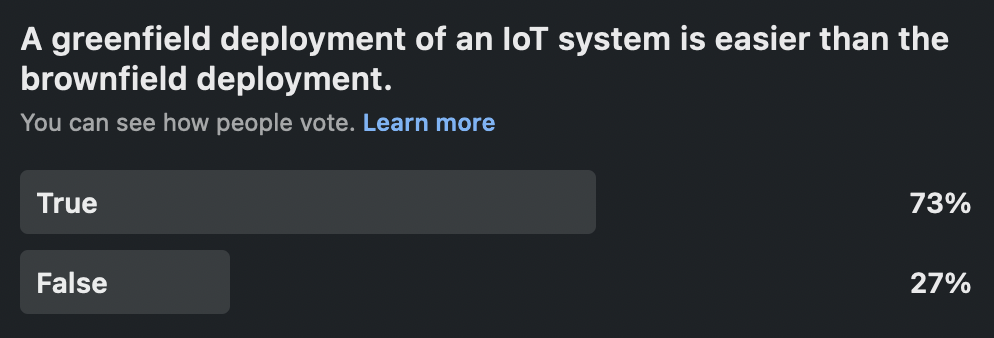
Introduction
In this post, I will share my experience regarding the greenfield vs brownfield projects.
I asked on LinkedIn if greenfield deployment is easier than brownfield and received the following votes:

Below I share my subjective opinion, feel free to reach out if you do not agree with me (I’m always eager to learn).
Definitions
Let’s start with brief definitions of the green- and brownfield deployments.
Greenfield project
According to Wikipedia, the greenfield project develops “a system for a totally new environment, without concern for integrating with other systems, especially not legacy systems." [link]
In other words, build something from scratch without any reference to existing solutions in the organization.
Brownfield project
According to Wikipedia, the brownfield project “implies that any new software architecture must take into account and coexist with live software already in situ”. [link]
In other words, some solution(s) already exists and needs to be included in the design of the new system/functionality.
My observations
Greenfield
The greenfield approach seems to be easier than the brownfield.
We start the greenfield initiative with the perception (and expectation) that we can “make it right” from the very beginning. Soon everyone realizes that the definition of the “right thing” is not that clear. During the first iteration, we build “something” that (typically) is not the “right thing”.
Why that is the case? What makes greenfield deployments soo hard?
The greenfield initiative is pure experimentation. It literally means that we are defining and building something completely new for the specific organization.
Internet of Things projects does not deliver business value by deploying some software and/or hardware solution. IoT initiatives should be business-oriented from the very begging. Greenfield means that we are introducing a business transformation by creating some new business processes and/or automating existing ones.
Business transformation projects are very difficult as they “operate on the living organism” (the enterprise) and introduce a change (which disturbs the safety of the as-is state).
Sometimes it is very hard to predict the business outcome of a greenfield initiative. If that is the case, I recommend using the iterative approach - design and build the greenfield solution in a way that can be easily modified and/or extended after the initial deployment. The project should secure resources (time and money) for a few iterations before the finalization of the greenfield initiative.
I do not agree that during the first iteration of the greenfield initiative we are creating the brownfield solution for subsequent changes (within the same project) - please continue reading to learn why.
Brownfield
One of the main challenges of a brownfield project is the discovery phase. We need to describe the existing business process that we are going to modify/extend during the engagement. Unfortunately, not every organization has detailed and up-to-date documentation of business processes. The same is true for legacy IT systems - sometimes the business logic needs to be reverse engineered during meetings with operators/users.
At the same time, the brownfield initiative needs to coexist (and integrate) with existing processes and infrastructure. It is impossible to successfully integrate with an unknown process and/or system.
In my opinion, that is why brownfield projects seem to be more difficult than greenfield ones. What is the biggest challenge of the brownfield initiative (the discovery phase) is the biggest advantage over the greenfield initiative. During the discovery phase, we define the expected business outcome based on already operating implementation. We put some extra work up front, but get a better idea of the valuable outcome of the solution we are building. I recommend the iterative approach to the brownfield projects, but (hopefully) they should require fewer iterations than the greenfield initiatives.
Summary
That is my personal, subjective view on the green vs brownfield deployments. I used to be a huge fan of greenfield deployments (sure I can do it right from the very begging!) but I gained humility over the years.
Thank you Charles Riggle and Martijn Quaedvlieg for the insightful conversation on LinkedIn; it enabled me to include additional concepts in this post and (hopefully) provide additional value for readers.

